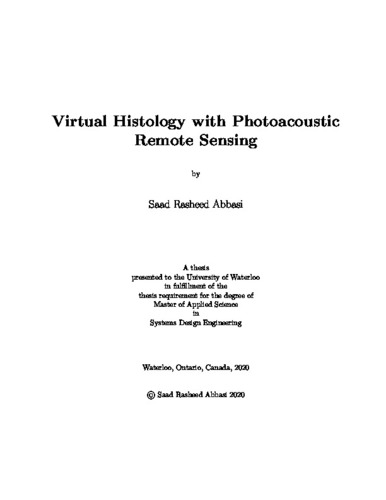| dc.contributor.author | Abbasi, Saad Rasheed | |
| dc.date.accessioned | 2020-09-01 15:20:29 (GMT) | |
| dc.date.available | 2020-09-01 15:20:29 (GMT) | |
| dc.date.issued | 2020-09-01 | |
| dc.date.submitted | 2020-08-19 | |
| dc.identifier.uri | http://hdl.handle.net/10012/16208 | |
| dc.description.abstract | Histopathology plays a central role in cancer screening, surgical margin analysis, cancer classification, and understanding disease progression. The vast majority of biopsies or surgical excisions are examined via transmission-mode bright-field microscopy. However, bright-field microscopy requires thin stained tissue samples as it is unable to visualize contrast on thick tissues. Consequently, biopsies and surgically excised specimens undergo extensive tissue processing to prepare histology slides. This tissue processing can take up to two weeks for complex cases before a diagnosis can be presented, potentially resulting in poorer patient outcomes. Surgical margins are commonly analyzed intraoperatively using frozen sectional analysis. While this technique has improved patient outcomes, the quality of frozen sections is often lower than post-operative histologic analysis. This lower quality leads to significant variability in diagnosis. Ultimately, both frozen section analysis and standard histologic analysis are limiting because of the need to process tissues to cater to bright-field microscopy. It would be desirable to forego creating thin tissue sections and instead visualize tissue morphology directly on biopsies and surgical specimens or even directly on the patient’s body (in-situ).
Photoacoustic remote sensing (PARSTM) is an emerging non-contact imaging technique. PARS microscopy is an all-optical photoacoustic imaging modality that takes advantage of endogenous optical absorption present within tissues to provide contrast to enable non- contact label-free imaging. PARS has demonstrated excellent resolution and contrast in various applications, such as in-vivo imaging, functional imaging, and deep imaging, while operating in a reflection-mode architecture. This non-contact label-free reflection-mode design lends itself well to imaging unprocessed tissue specimens or in-situ morphological assessment.
Using PARS microscopy, this thesis takes preliminary steps towards an in-situ surgical microscope. These steps take the form of developing a PARS system that can recover contrast from DNA and visualize the resulting nuclear morphology in real-time and on arbitrarily sized specimens. Later, this system was expanded to image additional contrasts from hemoglobin to approach the diagnostic information provided by standard histopathology. This research imaged a variety of human tissue types, including breast, gastrointestinal, and skin. These specimens were in the form of thin unstained slides and thick tissue blocks. The tissue blocks serve as an analog to visualization of contrast fresh tissues and in-situ imaging. Adjacent sections of each tissue type were prepared using standard histopathology and compared against the PARS images for experimental validation. These results represent the first reports of imaging human tissues with a non-contact label-free reflection-mode modality. The author believes this research takes vital steps towards an imaging technique that may one day reveal cancer in-situ. | en |
| dc.language.iso | en | en |
| dc.publisher | University of Waterloo | en |
| dc.subject | PARS histology virtual optics | en |
| dc.title | Virtual Histology with Photoacoustic Remote Sensing | en |
| dc.type | Master Thesis | en |
| dc.pending | false | |
| uws-etd.degree.department | Systems Design Engineering | en |
| uws-etd.degree.discipline | System Design Engineering | en |
| uws-etd.degree.grantor | University of Waterloo | en |
| uws-etd.degree | Master of Applied Science | en |
| uws.contributor.advisor | Hajireza, Parsin | |
| uws.contributor.affiliation1 | Faculty of Engineering | en |
| uws.published.city | Waterloo | en |
| uws.published.country | Canada | en |
| uws.published.province | Ontario | en |
| uws.typeOfResource | Text | en |
| uws.peerReviewStatus | Unreviewed | en |
| uws.scholarLevel | Graduate | en |

